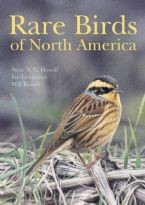Rare Birds of North America by Howell, Russell & Lewington

The book is something of a hybrid between a field guide and an encyclopaedic reference, but is certainly designed to be used as the latter. Being hardback and 420-odd pages, it's weighty and, with a well-designed jacket showing off a fine Lewington portrait of a vagrant Siberian Accentor, it's an immediately recognisable title.
British and Irish birders are well accustomed to the phenomenon of vagrancy: as we are at the northwestern periphery of the Western Palearctic, rare birds form a significant part of our own avifauna and thus a source of great fascination (and passion) — whether it be finding and seeing (twitching) them, or studying the synoptic conditions surrounding their occurrence. Therefore, most will find the introduction to Rare Birds of North America a genuinely engaging delight: tackling questions from the simplicity of 'what is a rare bird?' through to various theories on vagrancy and the points of the globe where North American vagrants originate, this is a detailed and illustrated essay-style opening that I found hugely enjoyable — and suspect most others will do too. What most fascinated me was the way familiar vagrancy theories to which we are accustomed in NW Europe, such as overshooting and drift, are applied in a Nearctic context. Being able to broaden one's horizons by applying a familiar concept to a less familiar geographic area is both thought-provoking and educational.
Following this are the species accounts, which make up the bulk of the book. Each entrant is discussed at length: distribution and status, summary of North American records, taxonomy, general comments (e.g. provenance, geographical origin) and field identification make up the text. Many of the species are relevant to British birders, some, such as Whooper Swan, Pink-footed Goose, Spotted Redshank or Blackbird, because of their status as established British species and others, such as Red-flanked Bluetail, Siberian Blue Robin, Brown Flycatcher or Black-browed Albatross, because they are sought-after mega-rarities for us too. When coupled with unfamiliar Neotropical and South Pacific vagrants, it makes for a wide-ranging, well-balanced and absorbing set of species accounts. For example, one might be entirely incompetent when confronted by Berylline Hummingbird yet force a wry smile when reading that Reed Bunting — such a familiar species to all of us — is an extremely rare and sought-after visitor to the westernmost Aleutians.
Ian Lewington's artwork is, as you'd expect, sensational. His work has come a long way since Europe's equivalent title — Rare Birds of Britain and Europe — which, though still good, was typically a lot more 'angular' and exaggerated. This time, though, it's faultless and worth buying the book for alone — and that's not to detract from Howell and Russell's magnificently thorough work on the text.
Rare Birds of North America is a really brilliant reference. A modern, fresh format with illustrations of the highest calibre equates to great looks, backed up by the content which, again, is of the highest order. This is a modern classic, and no doubt many European birders are now holding out for a Palearctic equivalent...let's hope it isn't too long coming!
Rare Birds of North America retails at £24.95, but is available to buy from the Birdwatch Bookshop at a reduced price of £21.95. Click here to order your copy.



